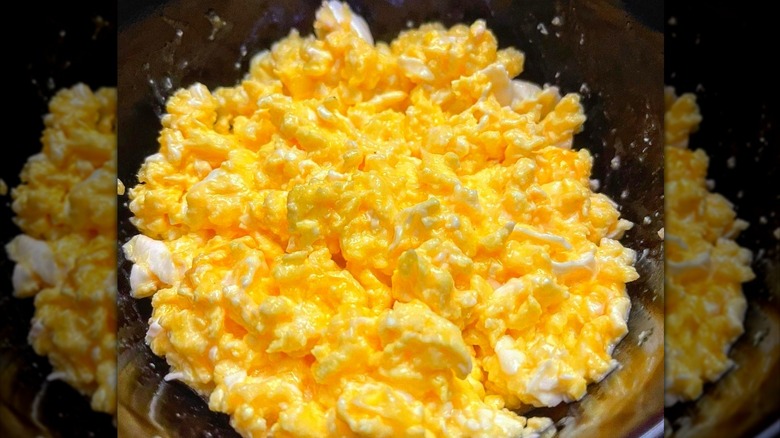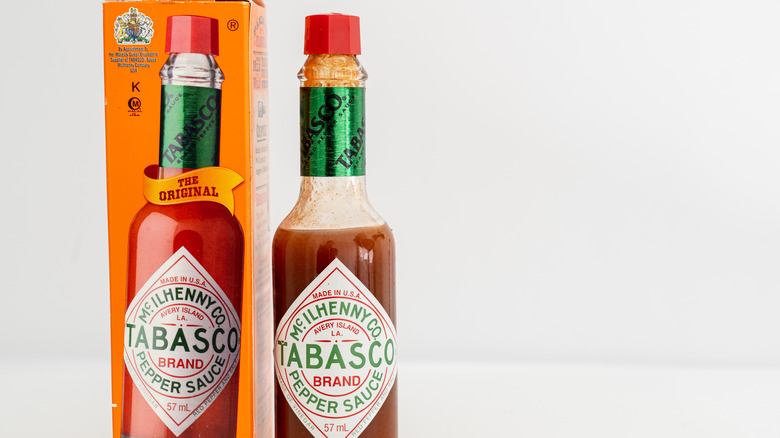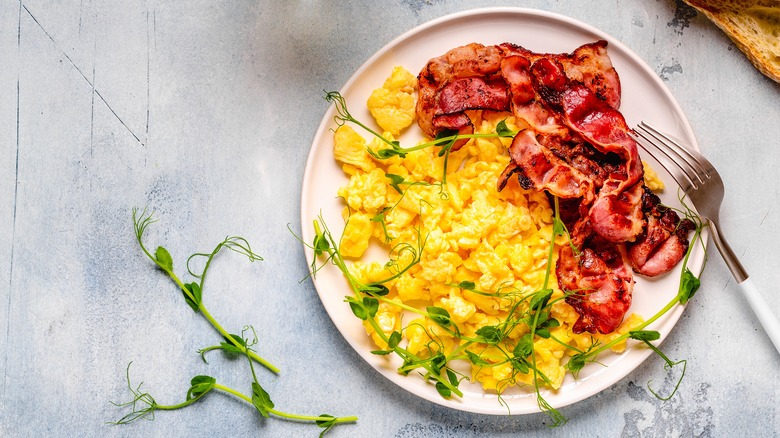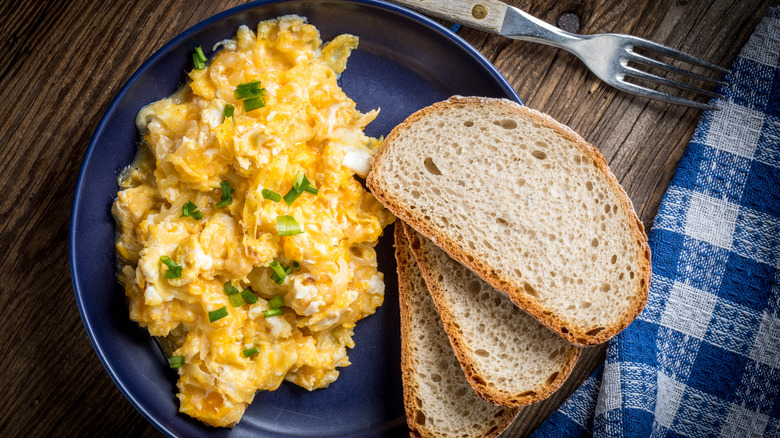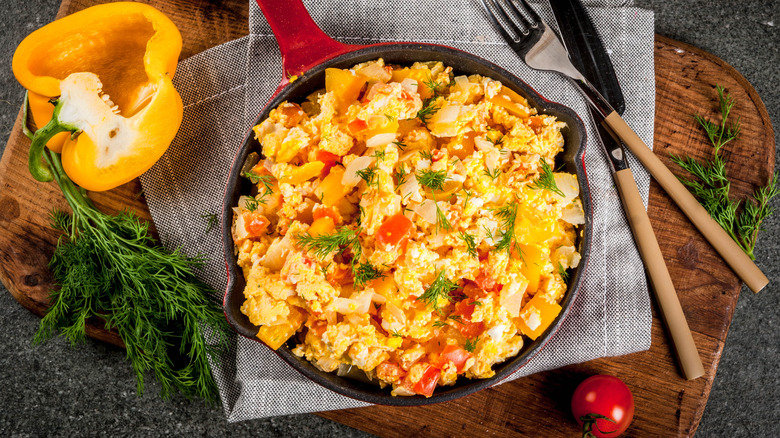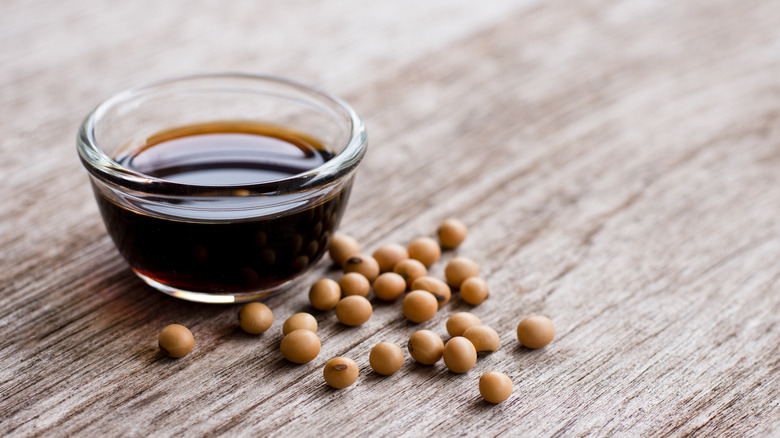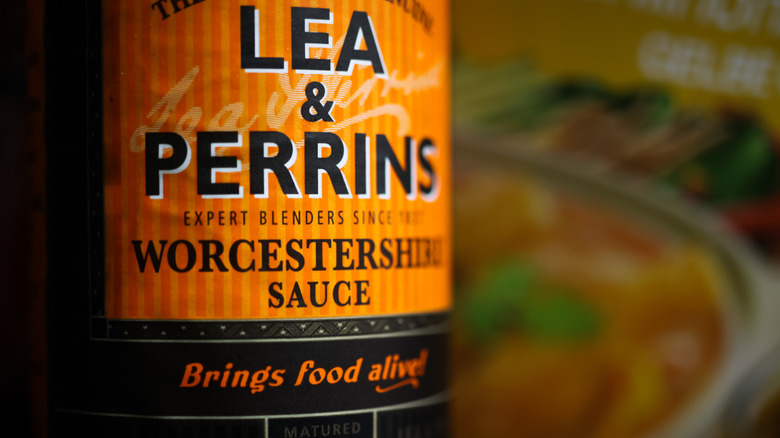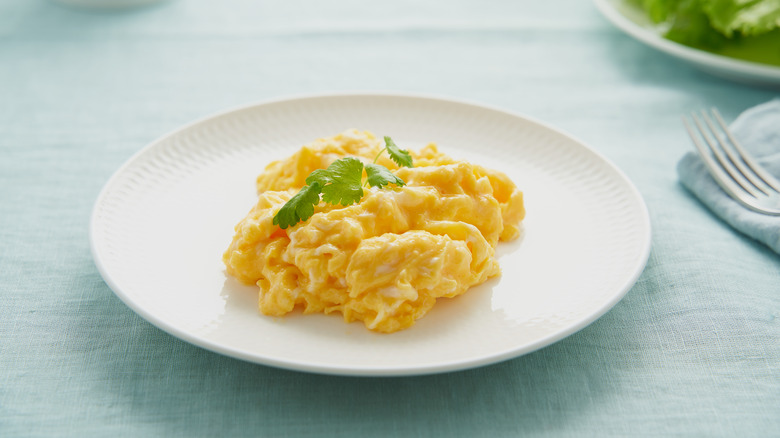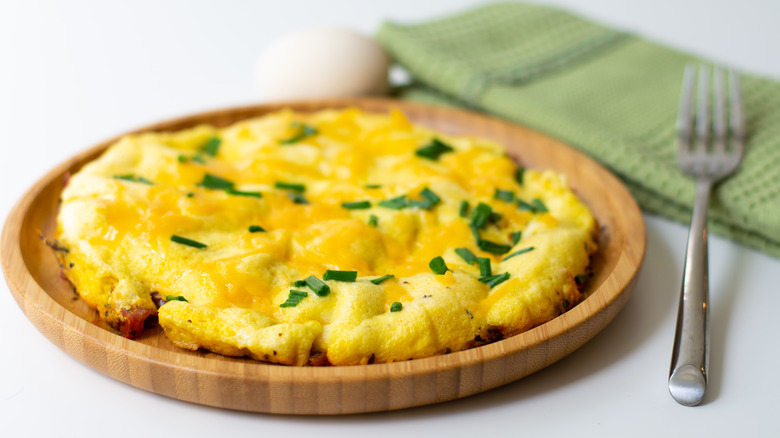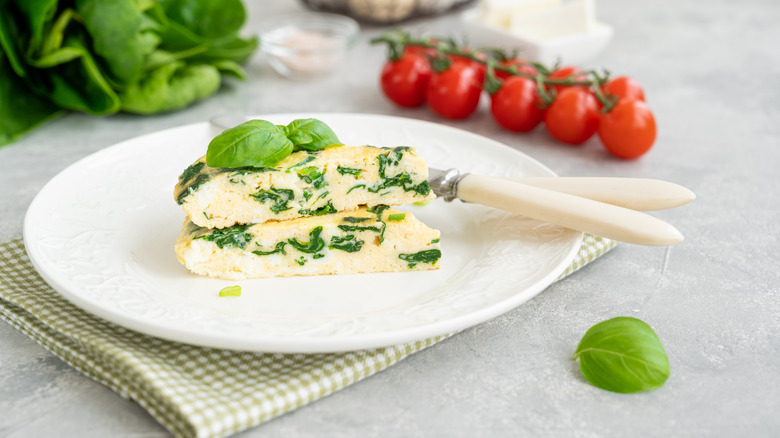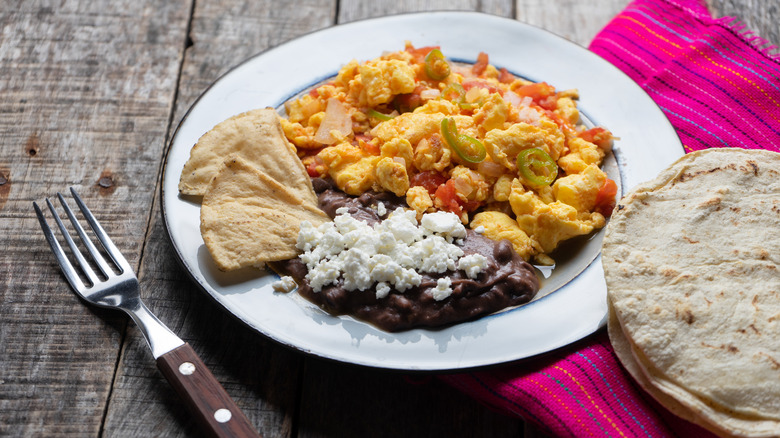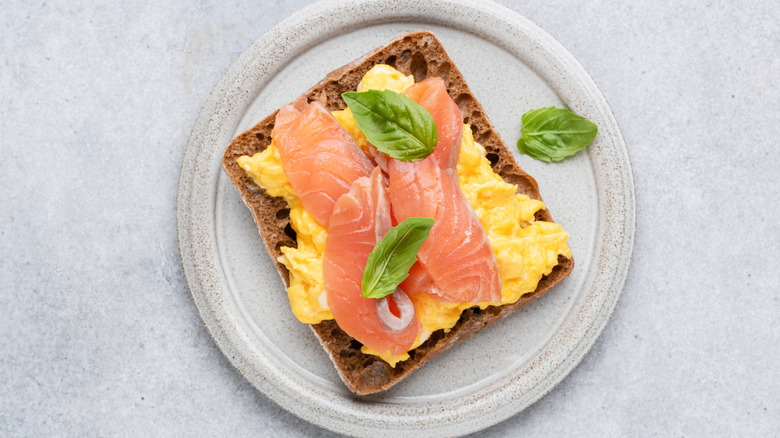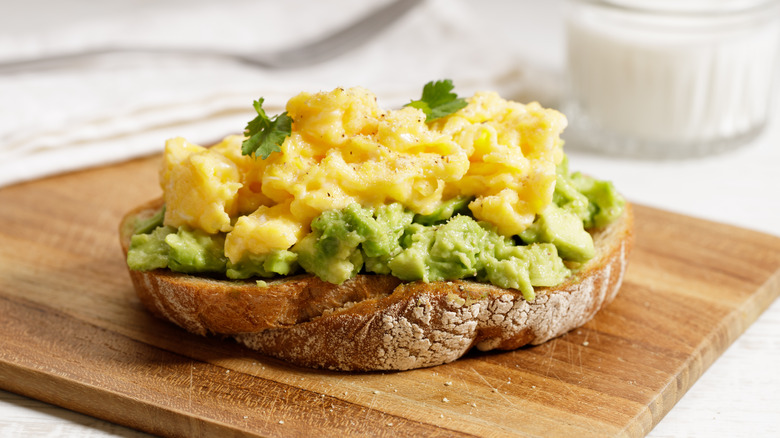Ingredients To Take Your Scrambled Eggs To The Next Level
We love our scrambled eggs. Whether they are served at a local greasy spoon or your favorite breakfast spot, enjoyed first thing in the morning or well into the night, they are one of our quickest, easiest go-tos for a food fill-up. Much like how we take our steak, or what we like on our hot dogs and burgers, we have a wide variety of ways to enjoy a good egg scram. We might be fans of one or all three of chef Jamie Oliver's scrambled-egg methods. Chef Gordon Ramsay has his own style, too. Maybe we like them served with a side of toast. If you want them on top of the toast and you know your diner vernacular, just ask for, "Adam and Eve on a raft, and wreck 'em!"
But if you're looking for that extra ingredient — beyond the basics of butter, salt, and pepper — to make your next breakfast really sing on your palate, consider some of the scrambled egg accoutrements that we've collected. You'll be happy to know that many of these ingredients are of the healthy variety and can serve as a boost to your scrambled-egg meal, taking it far beyond being just a potent source of protein.
Tabasco sauce
Almost ubiquitous on scrambled eggs as salt and pepper, hot sauce should still be touted as one of the best additions if you want a little extra kick in the morning. While a splash of hot sauce on morning eggs isn't anything new for some of us, Tabasco sauce in particular has the right balance of red pepper and vinegar that, according to Pepper Geek, makes it one of those sauces that cuts right into the eggs' flavor and knocks out any sort of blandness. While there is a veritable library of hot sauces out there, it might be safe to say that Tabasco seems to be made for scrambled eggs.
Even among the most devout hot-sauce aficionados, Tabasco is still a popular addition for those who want their breakfast to come with a touch of heat. And though hot, Tabasco isn't usually an eye-watering, throat-scalding kind of hot sauce — depending, of course, on your spice tolerance. The makers of Tabasco have been using the same recipe for more than 150 years, and we're betting scrambled eggs were probably one of the first things they tried it on.
Bacon
As avid breakfast eaters, we've been enjoying the eternally classic combo of bacon and eggs so much that it's practically hardwired into our brains, according to Eater. This perfect pairing is actually the result of a public relations push in the 1920s to sell more bacon, Eater reports. But who can argue with the salty, often crunchy strips of bacon that just pair naturally with a plate of steaming, fluffy eggs? Throw in a side of toast and some orange juice, and you've got yourself a full breakfast. But if these two early-morning staples go well adjacent to each other, how do they measure up mixed together?
Quite well, we must say. It's not uncommon to see bacon crumbled onto a fresh plate of scrambled eggs or even mixed in while cooking them on the stove. But be careful with the amount of bacon grease that gets mixed with the eggs. Too much leaves you with something more oily and less appetizing. The best method involves cooking the bacon ahead of time, almost to the point of drying it out. This will not only lessen the amount of grease, but also make the bacon crispy and easy to crumble so you can add the bits either into or onto your scrambled eggs.
Green onions
Whether you call them scallions or green onions – they're actually the same thing – these beauties go great with scrambled eggs. Though they're part of the onion family, green onions aren't packing nearly as onion-y a flavor when compared to their more bulbous cousins. Which isn't to say green onions aren't packing any flavor. Much to the contrary, what makes green onions such an ideal addition to scrambled eggs is that their flavor can change in subtle ways depending on how you use them.
Chopped and sprinkled raw onto a plate of eggs, green onions maintain their slight onion flavor and even add a bit of a fresh crunch when compared to the soft scramble. When green onions are cooked, however, an interesting transformation takes place. Allowing green onions to sauté at a lower heat with butter lets them caramelize and brings out an earthier sweetness. The sweetness isn't too overwhelming, though. Instead, this adds a totally new dimension to the more savory scrambled eggs.
Bell peppers
The colors of bell peppers are more than just for show. it turns out that each shade of bell pepper brings a different set of flavors to the table. And that's definitely true when pairing them with scrambled eggs. Keep in mind that each shade of color also represents a different level of a pepper's ripeness, which is something to consider, depending on what you want to bring to your egg dish.
Green peppers are the most common, and, according to Delishably, the most bitter. However, green peppers can be paired well with sweeter onions, especially when sautéed and caramelized, before you add to your eggs. Yellow peppers are known for their sweetness, and while they can be cooked, they can also be served raw, which means you can place a few slices on your scrambled eggs as a garnish. Orange peppers are sweet, but not as much as yellow peppers (via Delishably). On an aesthetic level, they do add a different hue to your usual yellow and white mound of eggs. Finally, if there's one pepper that's highly recommended, it's the red pepper. At its ripest point, a red pepper is not only high in flavor but also high in nutrition. Red peppers also add a strong splash of color to your breakfast.
Soy sauce
Salting eggs is often a highly debatable topic. Do you put salt in the batter while cooking, or just salt to taste after the eggs are done? Do you risk making your eggs bland or creating a watery egg island because salt pushes out the eggs' moisture? Cooks and chefs, pros and homemakers may all have their own methods when it comes to salting scrambled eggs, but apparently the true masters reach for the soy sauce before the salt shaker. Quite possibly one of the most common ingredients in a professional chef's repertoire of secret ingredients, soy sauce offers up all the flavor enhancements of salt without as high of a sodium content (via FoodStruct).
Not only that, but soy sauce is also able to fully spread itself out in scrambled eggs in a way that salt just can't. As granules, even in high numbers, salt always leaves gaps where your scrambled eggs go unseasoned and maybe become lackluster for flavor. As a liquid, however, soy sauce can fully coat the eggs, giving every bite a well-seasoned taste. If you want to know more about using soy sauce on scrambled eggs, find out more in this video from Mashed.
Worcestershire sauce
Speaking of salty sauces to add to your eggs: If you want a more British kick to your scramble and a bit more complexity, consider using Worcestershire sauce. This long-celebrated English import is made for more savory, hardier foods like steaks, burgers, and vegetables such as tomatoes and eggplant. It's also a key ingredient in many Caesar salad dressings. But Worcestershire can add a lot of inner umami to eggs, too, bringing out multiple dimensions of flavor.
Unlike soy sauce, Worcestershire is more than just fermented soy. While each version of Worcestershire is different, the majority of key ingredients include onion, garlic, sugar, molasses, malt vinegar, and anchovies, according to Kitchen Stories. With added spices and different levels of sugar and salt, the concoction makes for a tangy, spicy, and savory taste that adds to existing flavor while bringing more of its own. If you feel the need to experiment with your eggs, then Worcestershire is a place to start.
Parsley
While some may see parsley as mere decoration for an entrée, this herb is another classic scrambled-egg addition used either as a topping or in the mix. What makes parsley in particular such a popular herb for eggs is how it's able to lend a brighter, earthier, yet light taste to the more savory eggs. Parsley adds its own flavors and aromas to the dish without overpowering the entire palate. Not only that, but parsley is considered a "soft herb," according to Foods Guy, meaning that you can eat the entire plant, stem and all. You don't have to worry about picking off the leaves either, as you can chop up the entire plant as an ingredient.
Note that parsley is one of those herbs that is a bit too light for the fry pan. Too much heat can pull out parsley's appealing color and light flavor. Even worse, the heat risks completely drying out the parsley, making it brittle and un-flavorful to your eggs. When it comes to the best way to add parsley to your scrambled egg dish, consider a simple chop and a garnish just before your eggs are served.
Cheese
If you really want to talk about the sheer level of options and a veritable rainbow of flavors, then look no further than cheese to add to your scrambled eggs. Quite possibly more than any previous ingredient, cheese has got to be one of the most beloved egg additions, from omelets to frittatas. What helps, though, is knowing which cheeses pair well with eggs and which ones work better as a light garnish or melt well on the stovetop.
Cheddar is a classic through and through. Its flavor ranges from mild to sharp, and it lends a deep orange hue to scrambled eggs' yellow coloring. Depending on the cheese, it may not melt particularly well. Cheddar tends to work better as more of a garnish atop your eggs. Meltier cheeses like gouda and mozzarella practically marble into scrambled eggs, not only permeating the dish with their flavors, but also creating that cheesy, gooey texture that looks so appetizing in TV commercials for breakfast restaurants.
Another great cheese that melts well and has great taste is Swiss cheese, which is no wonder, considering it's a staple in fondues. It's worth noting that beyond the standard holey Swiss cheese that initially comes to mind, there are hundreds of varieties of cheese made in Switzerland, according to Food & Wine. What's great about adding cheese to your scrambled eggs is that you decide which cheese works best for your palate.
Spinach
Spinach mixed with scrambled eggs is another widely enjoyed changeup. Not only is it tasty, but it's also a great way to make sure you're getting your regular dose of vitamins and nutrients (via The Indian Express). While eggs tout plenty of protein, spinach contains a high number of essential vitamins that we tend to miss as part of our daily nutrition. Antioxidants, vitamins A, C, and K, and B-complex vitamins are part of spinach's nutritional makeup. Consuming foods high in these vitamins promotes muscle growth and bone health as well as healthier and younger-looking skin, according to Medical News Today.
But enough about health. How does it taste? Well, when paired with cheese or other vegetables, spinach helps make your scrambled eggs a bit more hearty. But if you're going to add spinach into your eggs, remember to cook the spinach beforehand. Spinach is a leafy vegetable that reduces after a few minutes of heat. As it reduces, it will shed all of its water content. So unless you want your cooked eggs to really be swimming, add the spinach after you have cooked it.
Salsa
Several vegetables go well with scrambled eggs, as does a kick of spice, but what if you want that whole medley all at once? Look no further than a jar of store-bought (or even homemade) salsa. And just because it's salsa doesn't mean it has to have some heat to it. Even better, check out your local grocery section, and you'll see salsas with a wide array of textures, ingredients, and levels of spice. If you want to even go further, making your own salsa is far easier than you think, provided you know the basics. Plus, that gives you total control as to what vegetables, levels of heat, and consistency of salsa you want to add to your eggs.
What's also great about salsa is the versatility you get in how it's added to your eggs. Mexican style salsa, which usually has tomatoes, cilantro, jalapeño peppers, salt, and onion, can easily be cooked into your scrambled eggs, creating an even heat and even changing the flavor of the salsa as it cooks. Italian-style salsa, commonly made with olive oil, capers, garlic, lemon juice, or vinegar, is best served as a condiment to scrambled eggs.
Salmon
If you want to avoid being that person who stinks up the office break room by microwaving leftover salmon, consider folding those seafood scraps into your scrambled eggs. A breakfast scramble is one of those dishes where eggs mix well with almost any kind of leftover food. Salmon is absolutely one of those kinds of leftovers. Heck, even making it fresh for the sole purpose of adding it to scrambled eggs is still totally valid.
There are several different types of salmon to consider, from Atlantic to Coho, according to Luxofood. You'll also need to decide whether to use fresh or smoked salmon, which has an entirely different sort of flavor, Luxofood reports.
Much like spinach, salmon is one of those ingredients added to scrambled eggs for those looking for a healthier meal plan. It should be no surprise for the health-conscious that salmon is known to contain a high level of omega-3 fatty acids (via Healthline), which is equivalent to getting some high-grade lubrication for your arteries. Not only that, but salmon also contains high levels of B12, a key vitamin used by the body to create healthier red blood cells and promote a healthier brain, Healthline reports. While these days seafood is rather expensive, even half a pound of leftover salmon can do wonders for your breakfast the following morning.
Avocado
Avocado is one of those universal ingredients that seems to go great with almost anything, from a simple piece of toast to the inside of a generously stuffed burrito. So naturally, avocado lends its own unique flavor, nutrients, and creamy texture when added to your scrambled eggs. In fact, eggs and avocado are a healthy, nutricious tag-team powerhouse. You're not only getting your proteins, but also plenty of healthy fats and minerals like magnesium, zinc, and selenium. Along with a high level of amino acids, an egg/avocado combo provides health benefits like improving your general mood and sharpening your brain by feeding your neurotransmitters and helping create feel-good brain chemicals like dopamine, La Cucina Italiana reports.
As good as this combination is for your body and mind, just keep in mind not to eat it every single day. Avocado is still high in fats, and eggs still contain a level of bad cholesterol. But like any food, if you make it part of a balanced meal plan each week, you'll be able to enjoy the benefits while avoiding the drawbacks from over-indulgence. Speaking of over-indulgence, while you can have avocado just as a garnish or mixed in while cooking your scrambled eggs, the two are also prime ingredients for a breakfast burrito!
Honey
If you thought honey scrambled eggs must be some new hipster trend, you'll be surprised to learn that adding honey to breakfast eggs dates back to ancient Rome. The recipe that appeared in Apicius (a cookbook from the 300s C.E.) is called "ova spongia ex lacte," which translates to "spongy eggs from milk." It involves cooking a mixture of eggs, milk, and oil like an omelet and, once cooked, adding a drizzling of honey with freshly ground pepper. While it's not scrambled eggs (unless your omelet fails), it combines eggs and honey for breakfast. It also showcases the easiest way to make scrambled honey eggs: just drizzle honey on top of your regular scrambled eggs.
Famed physicist Albert Einstein used to fry his eggs in a melted mixture of butter and honey, which is also the perfect way to make scrambled eggs so that the honey is incorporated into them better. Just mix a teaspoon of honey with a teaspoon of melted butter in your skillet and add your egg mixture for scrambling. The butter and honey will infuse the scrambled eggs with a flavor that is unparalleled. Some cooks like to add other seasonings, like a dash of garlic powder, a pinch of nutmeg, and a pinch of allspice, to their eggs. Another way to fancy up this unique scrambled egg dish is to add your favorite cheese and roasted walnuts along with the honey. Appropriate cheeses include cream cheese, gouda, blue cheese, or fresh Parmesan.
